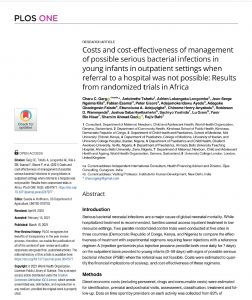
Introduction
Serious bacterial neonatal infections are a major cause of global neonatal mortality. While hospitalized treatment is recommended, families cannot access inpatient treatment in low resource settings. Two parallel randomized control trials were conducted at five sites in three countries (Democratic Republic of Congo, Kenya, and Nigeria) to compare the effectiveness of treatment with experimental regimens requiring fewer injections with a reference regimen A (injection gentamicin plus injection procaine penicillin both once daily for 7 days) on the outpatient basis provided to young infants (0-59 days) with signs of possible serious bacterial infection (PSBI) when the referral was not feasible. Costs were estimated to quantify the financial implications of scaleup, and cost-effectiveness of these regimens.
Methods
Direct economic costs (including personnel, drugs and consumable costs) were estimated for identification, prenatal and postnatal visits, assessment, classification, treatment and follow-up. Data on time spent by providers on each activity was collected from 83% of providers. Indirect marginal financial costs were estimated for non-consumables/capital, training, transport, communication, administration and supervision by considering only a share of the total research and health system costs considered important for the program. Total economic costs (direct plus indirect) per young infant treated were estimated based on 39% of young infants enrolled in the trial during 2012 and the number of days each treated during one year. The incremental cost-effectiveness ratio was calculated using treatment failure after one week as the outcome indicator. Experimental regimens were compared to the reference regimen and pairwise comparisons were also made.
Results
The average costs of treating a young infant with clinical severe infection (a sub-category of PSBI) in 2012 was lowest with regimen D (injection gentamicin once daily for 2 days plus oral amoxicillin twice daily for 7 days) at US$ 20.9 (95% CI US$ 16.4-25.3) or US$ 32.5 (2018 prices). While all experimental regimens B (injection gentamicin once daily plus oral amoxicillin twice daily, both for 7 days), regimen C (once daily of injection gentamicin injection plus injection procaine penicillin for 2 days, thereafter oral amoxicillin twice daily for 5 days) and regimen D were found to be more cost-effective as compared with the reference regimen A; pairwise comparison showed regimen D was more cost-effective than B or C. For fast breathing, the average cost of treatment with regimen E (oral amoxicillin twice daily for 7 days) at US$ 18.3 (95% CI US$ 13.4-23.3) or US$ 29.0 (2018 prices) was more cost-effective than regimen A. Indirect costs were 32% of the total treatment costs.